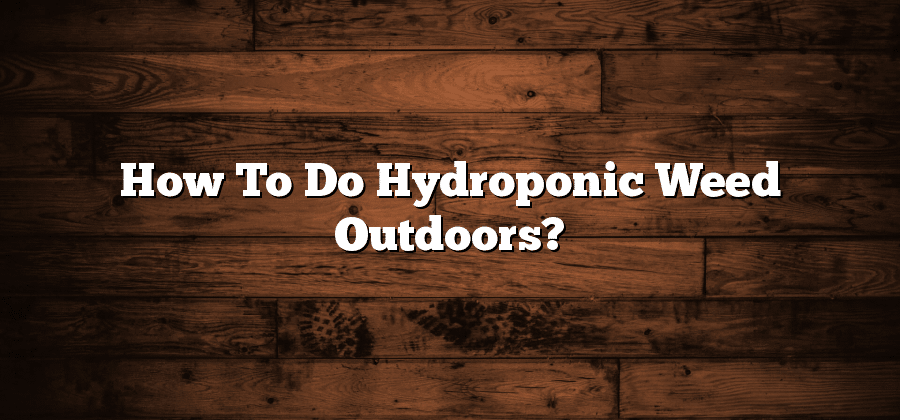Benefits of Outdoor Hydroponic Weed Cultivation
Outdoor hydroponic weed cultivation offers numerous benefits for growers. Firstly, it allows for better control over the growing environment, resulting in healthier and more potent plants. With hydroponics, growers have the ability to adjust variables such as nutrient levels, pH levels, and light exposure to maximize plant growth and cannabinoid production. This translates to higher yields of high-quality weed that is rich in desirable compounds, ultimately leading to more satisfied customers.
Secondly, outdoor hydroponic cultivation significantly reduces the risk of pests and diseases compared to traditional outdoor growing methods. By growing plants above ground, in a controlled system, the risk of soil-borne pests, soil-borne diseases, and weed competition is greatly minimized. This not only saves growers the hassle of dealing with infestations or diseases but also reduces the need for chemical pesticides and herbicides. As a result, hydroponically grown weed tends to be cleaner and safer for consumption.
Selecting the Ideal Outdoor Location
When it comes to selecting the ideal outdoor location for your hydroponic weed cultivation, there are several factors that need to be considered. First and foremost, you need to find an area that receives ample sunlight throughout the day. This is crucial for the growth and development of your plants. Look for a spot in your garden or yard that is not obstructed by tall buildings or trees, as this may cast shadows and limit the amount of sunlight your plants receive. Additionally, it is important to choose a location that has good air circulation. Adequate airflow helps prevent the buildup of moisture and reduces the risk of pests and diseases affecting your plants. Take note of any nearby structures or barriers that may affect the movement of air, and opt for an open and well-ventilated area for optimal results.
Preparing the Hydroponic System
When preparing the hydroponic system for outdoor weed cultivation, there are several important factors to consider. Firstly, it is crucial to choose the right type of system that will effectively support the growth of your plants. The system should provide the necessary water, nutrients, and oxygen to the roots, ensuring healthy and robust cannabis plants.
One key aspect of preparing the hydroponic system is selecting the appropriate growing medium. Unlike traditional soil-based cultivation, hydroponics relies on inert materials to anchor the plants and provide support. Popular options include rockwool, coco coir, clay pebbles, and perlite. Each medium has its unique characteristics, such as water retention or aeration capabilities, so it is important to understand the needs of your specific strains and choose accordingly. Additionally, the chosen medium should be thoroughly cleaned and pre-soaked before planting to remove any potential contaminants or impurities. By thoroughly and thoughtfully preparing the hydroponic system, you set the stage for successful outdoor weed cultivation.
Choosing the Right Nutrients for Outdoor Hydroponic Weed
When it comes to outdoor hydroponic weed cultivation, choosing the right nutrients is crucial for the success of your plants. With the absence of traditional soil, you need to provide your plants with all the essential nutrients they need to thrive. This means selecting the appropriate nutrient solution specifically formulated for hydroponic systems.
The nutrient solution should contain a balanced combination of macronutrients, such as nitrogen, phosphorus, and potassium, as well as micronutrients like iron, magnesium, and calcium. These nutrients play a vital role in the overall growth and development of your plants, from promoting healthy foliage to enhancing bud development. Additionally, it is important to choose a nutrient solution that is water-soluble and easily absorbed by the plants, ensuring maximum nutrient uptake and avoiding nutrient deficiencies.
Understanding Lighting Requirements for Outdoor Hydroponic Weed
When it comes to outdoor hydroponic weed cultivation, understanding the lighting requirements is crucial for the success of your crop. Unlike traditional outdoor farming, where plants rely solely on natural sunlight, growing hydroponically outdoors requires additional lighting to provide the necessary spectrum and intensity for optimal growth.
The first consideration in lighting requirements is the duration of light exposure. Marijuana plants generally require a minimum of 12 hours of continuous light exposure to grow properly, but some strains may benefit from up to 18 hours of light during the vegetative stage. This can be achieved through a combination of natural sunlight and artificial lighting sources, such as high-intensity discharge (HID) lamps or light-emitting diodes (LEDs). It is important to find the right balance between natural and artificial light to avoid excessive heat and energy consumption.
The second aspect to consider is the type of light spectrum needed for the different stages of plant growth. During the vegetative phase, plants need more blue light, which promotes leaf and stem development. In the flowering stage, plants require more red light, as it encourages bud formation and flowering. LED grow lights are the preferred choice for many outdoor hydroponic growers due to their ability to provide a full spectrum of light that can be adjusted for each growth stage. Additionally, LEDs are more energy-efficient and emit less heat compared to traditional HID lamps.
Understanding the lighting requirements for outdoor hydroponic weed cultivation is vital to ensure healthy plant growth and maximize yields. By providing the right amount and spectrum of light, growers can create an ideal growing environment for their plants, regardless of the surrounding natural sunlight conditions. By harnessing the power of both natural and artificial lighting, outdoor hydroponic cultivators can capitalize on the benefits of this innovative and sustainable growing method.






